Python Dictionary Guide: 10 Python Dictionary Methods & Examples
Master Python Dictionaries and their essential functions in 15 minutes with this introductory guide.
By Michael Galarnyk, Data Scientist
This Python Dictionary tutorial covers:
- How to Define a Dictionary
- How to Access Values in a Dictionary
- How to Add, Update, and Delete Keys from a Dictionary
- Python Dictionary Methods
- How to Iterate through a Dictionary
With that, let’s get started.
Define a Python Dictionary
Dictionaries are written within curly brackets {}.

# Define a dictionary code
webstersDict = {'person': 'a human being',
'marathon': 'a running race that is about 26 miles',
'resist': 'to remain strong against the force',
'run': 'to move with haste; act quickly'}
The dictionary webstersDict used strings as keys in the dictionary, but dictionary keys can be any immutable data type (numbers, strings, tuples etc). Dictionary values can be just about anything (int, lists, functions, strings, etc).
For example, the dictionary below, genderDict has ints as keys and strings as values.
# Define a dictionary
genderDict = {0: 'male',
1: 'female'}
An important point to emphasize is that if you try to make a key a mutable datatype (like a list), you will get an error.
# Failure to define a dictionary
webstersDict = {(1, 2.0): 'tuples can be keys',
1: 'ints can be keys',
'run': 'strings can be keys',
['sock', 1, 2.0]: 'lists can NOT be keys'}

Access Values in a Python Dictionary
To access a dictionary value, you can use square brackets [].
For example, the code below uses the key ‘marathon’ to access the value ‘a running race that is about 26 miles’.
# Get value of the 'marathon' key webstersDict['marathon']

Keep in mind that you will get a KeyError if you try to access a value for a key that does not exist.
# Try to get value for key that does not exist webstersDict['nonexistentKey']

In the Python Dictionary Methods section, you will see the utility of using the dictionary method get to avoid KeyErrors.
Add, Update, and Delete Keys from a Python Dictionary
Add or Update Key
You can add a new key-value pair.
# add one new key value pair to a dictionary webstersDict['shoe'] = 'an external covering for the human foot'

You can also update a key-value pair.
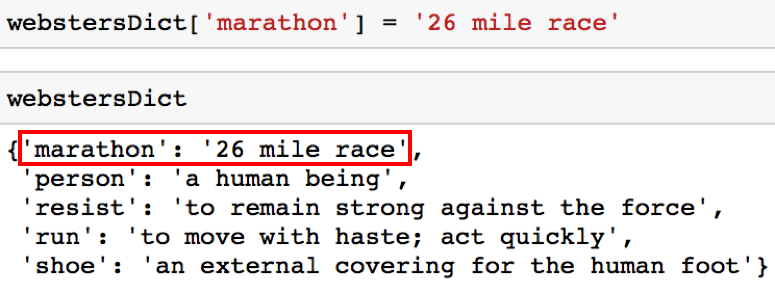
In the Python Dictionary Methods section, you will see that you can also add or update multiple key value pairs at a time using the dictionary update method.
Delete Keys from Python Dictionary
It is possible to remove a key and its corresponding value from a dictionary using del.
# Remove the key 'resist' from the dictionary del webstersDict['resist']

In the Python Dictionary Methods section, you will see that you can also delete keys using the dictionary pop method.
Python Dictionary Methods
Python dictionaries have different methods that help you modify a dictionary. This section of the tutorial just goes over various python dictionary methods.
update method
The update method is very useful for updating multiple key values pairs at a time. It takes a dictionary as an argument.
# Using update method to add two key value pairs at once
webstersDict.update({'ran': 'past tense of run',
'shoes': 'plural of shoe'})

get method
# Define a dictionary
storyCount = {'is': 100,
'the': 90,
'Michael': 12,
'runs': 5}
The get method returns a value for a given key. If a key doesn’t exist, the dictionary will by default return None.
# Since the key 'Michael' exists, it will return the value 12
storyCount.get('Michael')

The method is very useful to look up keys you don’t know are in the dictionary to avoid KeyErrors.
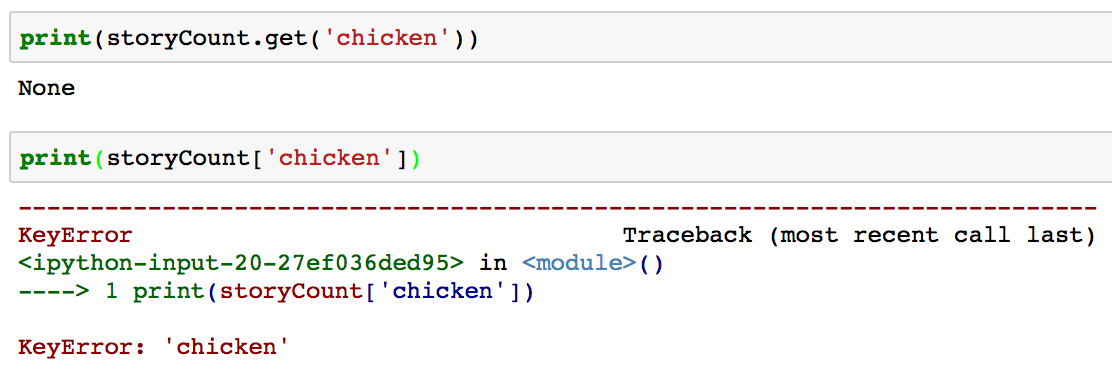
You can also specify a default value to return if the key doesn’t exist.
# Make default value for key that doesn't exist 0.
storyCount.get('chicken', 0)
pop Method
The pop method removes a key and returns the value.
storyCount.pop('the')
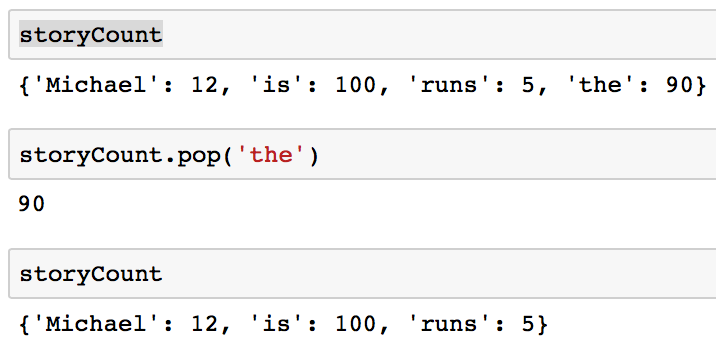
keys Method
The keys method returns the keys of the dictionary.
storyCount.keys()

values Method
The values method returns the values in the dictionary.
storyCount.values()
items Method
The items method returns a list like object of tuples where each tuple is of the form (key, value).
webstersDict.items()

Iterate through a Dictionary
You can iterate through the keys of a dictionary by using a for loop.
for key in storyCount: print(key)

You also iterate through the keys of a dictionary by using the keys method.
for key in storyCount.keys(): print(key)
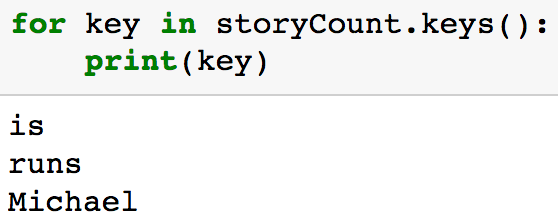
The for loop below uses the items method to access one (key, value) pair on each iteration of the loop.
for key, value in webstersDict.items():
print(key, value)
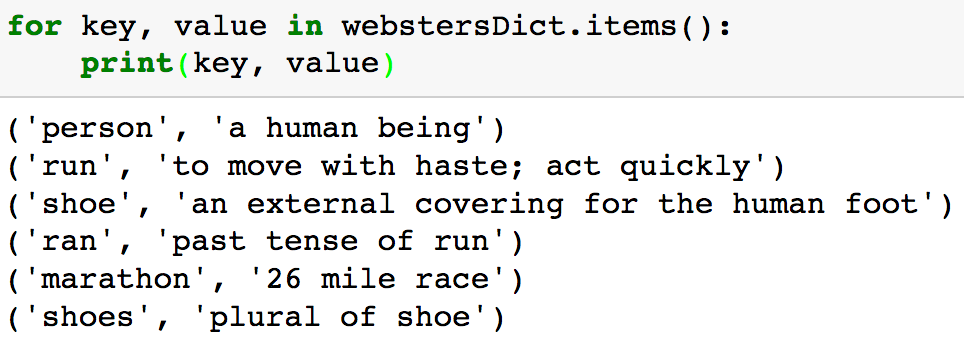
If you have difficulty understanding this section, I recommend watching the following video.
Closing Remarks
Please let me know if you have any questions either here or through Twitter! The next post, Python Word Count will review Python dictionary methods, list manipulations, and string manipulations. If you want to learn how to utilize the Pandas, Matplotlib, or Seaborn libraries, please consider taking my Python for Data Visualization LinkedIn Learning course. Here is a free preview video.
Bio: Michael Galarnyk is a Data Scientist and Corporate Trainer. He currently works at Scripps Translational Research Institute. You can find him on Twitter (https://twitter.com/GalarnykMichael), Medium (https://medium.com/@GalarnykMichael), and GitHub (https://github.com/mGalarnyk).
Original. Reposted with permission.
Related:

